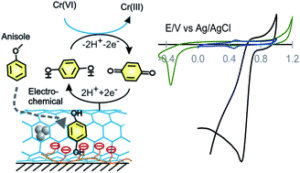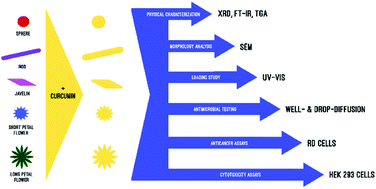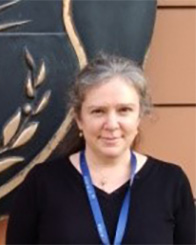We are very pleased to introduce Annamalai Senthil Kumar, Desika Rajagopal and Mansi Gandhi, authors of the paper ‘In situ electro-organic synthesis of hydroquinone using anisole on MWCNT/Nafion modified electrode surface and its heterogeneous electrocatalytic reduction of toxic Cr(vi) species‘. Their article has been very well received and handpicked by our reviewers and handling editors as one of our January HOT articles. The authors told us more about the work that went into this article and what they hope to achieve in the future. You can find out more about their article below and find more HOT articles in our online collection.
Meet the authors
 Annamalai Senthil Kumar is a Senior Professor, Dept. of Chemistry, School of Advanced Sciences, Vellore Institute of Technology (VIT), Tamil Nadu, India & part of CO2 Research and Green Technology Centre, VIT. His research interest includes interdisciplinary areas of Nano-, Bio- and Molecular- Electrochemistry especially design and development of redo active chemically modified electrode for electrocatalytic and electrochemical sensor applications. He has published nearly 200 publications (Scopus Index(R); 7406627815). His h-index value is 36. He has been serving as an Advisory Board member of Analyst (RSC) (2014-) and an (Invited) elected member of Fellow Royal Society of Chemistry (FRSC).
Annamalai Senthil Kumar is a Senior Professor, Dept. of Chemistry, School of Advanced Sciences, Vellore Institute of Technology (VIT), Tamil Nadu, India & part of CO2 Research and Green Technology Centre, VIT. His research interest includes interdisciplinary areas of Nano-, Bio- and Molecular- Electrochemistry especially design and development of redo active chemically modified electrode for electrocatalytic and electrochemical sensor applications. He has published nearly 200 publications (Scopus Index(R); 7406627815). His h-index value is 36. He has been serving as an Advisory Board member of Analyst (RSC) (2014-) and an (Invited) elected member of Fellow Royal Society of Chemistry (FRSC).
 Dr. Desikan Rajagopal is Professor and Head of the Department of Chemistry at School of Advanced Sciences, VIT University, Vellore. His research interest includes the design and organic-synthesis of biologically relevant organic molecules, electro-organic synthesis and medicinal chemistry. Prior to this, he was leading a drug development program for cardiovascular disease at Columbus in USA. He has published more than 47 research papers, six US patents and seven book chapters. Apart from research, he is highly passionate in teaching to undergraduate and masters students in the specialized areas of chemistry. He is also a consultant to several industries.
Dr. Desikan Rajagopal is Professor and Head of the Department of Chemistry at School of Advanced Sciences, VIT University, Vellore. His research interest includes the design and organic-synthesis of biologically relevant organic molecules, electro-organic synthesis and medicinal chemistry. Prior to this, he was leading a drug development program for cardiovascular disease at Columbus in USA. He has published more than 47 research papers, six US patents and seven book chapters. Apart from research, he is highly passionate in teaching to undergraduate and masters students in the specialized areas of chemistry. He is also a consultant to several industries.
 Mansi Gandhi is a Research Scholar working under Prof Desikan Rajagopal and Prof A Senthil Kumar on topic In-situ electro-organic synthesis and electrocatalysis.
Mansi Gandhi is a Research Scholar working under Prof Desikan Rajagopal and Prof A Senthil Kumar on topic In-situ electro-organic synthesis and electrocatalysis.
Could you briefly explain the focus of your article to the non-specialist (in one or two sentences only) and why it is of current interest?
Conventional organic synthesis and electro-organic synthesis are known in the literature. However, carbon nano tube mediated organic reactions is either unknown or scarce. Herein, we introduce a new concept of “in-situ electro-organic synthesis” of a redox-active molecule, hydroquinone on MWCNT modified glassy carbon electrode surface with anisole as a precursor.
How big an impact could your results potentially have?
It is a novel and new method to prepare a chemically modified electrode of a desired organic redox-active molecule for selective electrochemical sensor and bio-electrochemical sensor applications. This may be considered as a game-changer in the field of electrochemical sensors.
Could you explain the motivation behind this study?
This study aims at integrating a multi-disciplinary approach involving organic chemistry, electrochemistry, nanotechnology and bio-sensor areas.
The development of new redox-active organic molecules-based chemically modified electrodes that are stable under the working condition and effective towards targeted analyte are rarely reported in the literature. Similarly, high-valent Cr(VI) species have been used as an oxidant for the alcohol oxidation reaction. In this work, we have reversed the concept, i.e, redox-active polyphenolic compound, Hydroquinone modified electrode for Cr(VI) reduction reaction, has been introduced.
In your opinion, what are the key design considerations for your study?
A strong surface-confined electrochemical oxidation of organic precursors on graphitic material via π- π interaction is a key step for this new concept.
Which part of the work towards this paper proved to be most challenging?
Isolation of extremely minute quantity fraction of the redox-active organic compound trapped on the MWCNT and its characterization by GC-MS and NMR.
What aspect of your work are you most excited about at the moment?
Introduction and coining the concept “In-situ Electro-organic synthesis” for the development of new redox-active chemically modified electrodes.
What is the next step? What work is planned?
With this new concept, we will like to oxidize inert and difficultly-oxidizable substances like benzene and polyaromatic hydrocarbon on the graphitic surface to develop certain molecular-electronic materials.
In situ electro-organic synthesis of hydroquinone using anisole on MWCNT/Nafion modified electrode surface and its heterogeneous electrocatalytic reduction of toxic Cr(vi) species
Mansi Gandhi, Desikan Rajagopal and Annamalai Senthil Kumar
RSC Adv., 2021,11, 4062-4076
DOI: 10.1039/D0RA10370E, Paper
 Submit to RSC Advances today! Check out our author guidelines for information on our article types or find out more about the advantages of publishing in a Royal Society of Chemistry journal.
Submit to RSC Advances today! Check out our author guidelines for information on our article types or find out more about the advantages of publishing in a Royal Society of Chemistry journal.
Keep up to date with our latest HOT articles, Reviews, Collections & more by following us on Twitter. You can also keep informed by signing up to our E-Alerts.

















